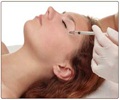The popular Botox cosmetic treatment could do a lot more than improving one’s looks, including offer treatment for migraines.
A number of breakthrough have been reported on the Botox reported in recent years. Its no more just a treatment aimed at bettering your looks, it seems.
In a preliminary study in 2005 of 350 headache suffers, Botox-treated subjects said they had 7.1 fewer migraines over a 30-day period, compared with a control group of headache sufferers who reported 3.7 fewer attacks.Collagen, a natural substance found in connective tissue was approved in the United States in 1981 for “filling out” faces—enter Zyplast and Zyderm. But it wasn’t until Botox (approved for cosmetic use in 2002) that the market for youthifying drugs, facial skin fillers, and other nonsurgical devices took off. Today it’s plumped to well over $12 billion, says the popular internet magazine Health.
The U.S. Food and Drug Administration (FDA) first approved a Botox-like drug called Oculinum in 1989 to treat uncontrolled blinking and lazy eye.
In 2003, a filler called Restylane got a reputation for erasing nasolabial folds (the parentheses that contain the nose), smile lines, and creases above the mouth. Restylane has a hyaluronic acid (a naturally occurring lubricant found in joints) base.
After seeing how Botox works, some cosmetic surgeons and dermatologists s are trying long-wave pulsed-light-lasers, diode lasers, infrared light, and even radio frequency heat wave treatments in their efforts to repair the skin in this area.
This year, the FDA approved Juvéderm, a hyaluronic acid–based filler that claims to last a year. And in 2006, the agency OK’d Radiesse (a semipermanent filler for nasolabial folds, marionette lines, and acne scars that can last as long as two years) and Artefill (the first permanent filler to get FDA approval).
Advertisement
In 2001, Myobloc (botulinum toxin type B) began being used to treat muscle spasms associated with cervical dystonia, a neurologoical condition; it also may be helpful in treating tricky cases of whiplash.
Advertisement
• Pig-tissue collagen injectibles, already approved and in use in Europe, may be less likely to cause allergic reactions than cattle-derived versions. One leading brand, Evolence, lasts 12 months.
• Gamma amino-butryic acid (GABA) blocks neu-rotransmitters, relaxing muscles and leading to shallower (less visible) wrinkles.
Creams or serums with GABA aren’t yet approved by the FDA, but are already gaining fans among needle-nervous Nellies.
Source-Medindia
GPL/M









